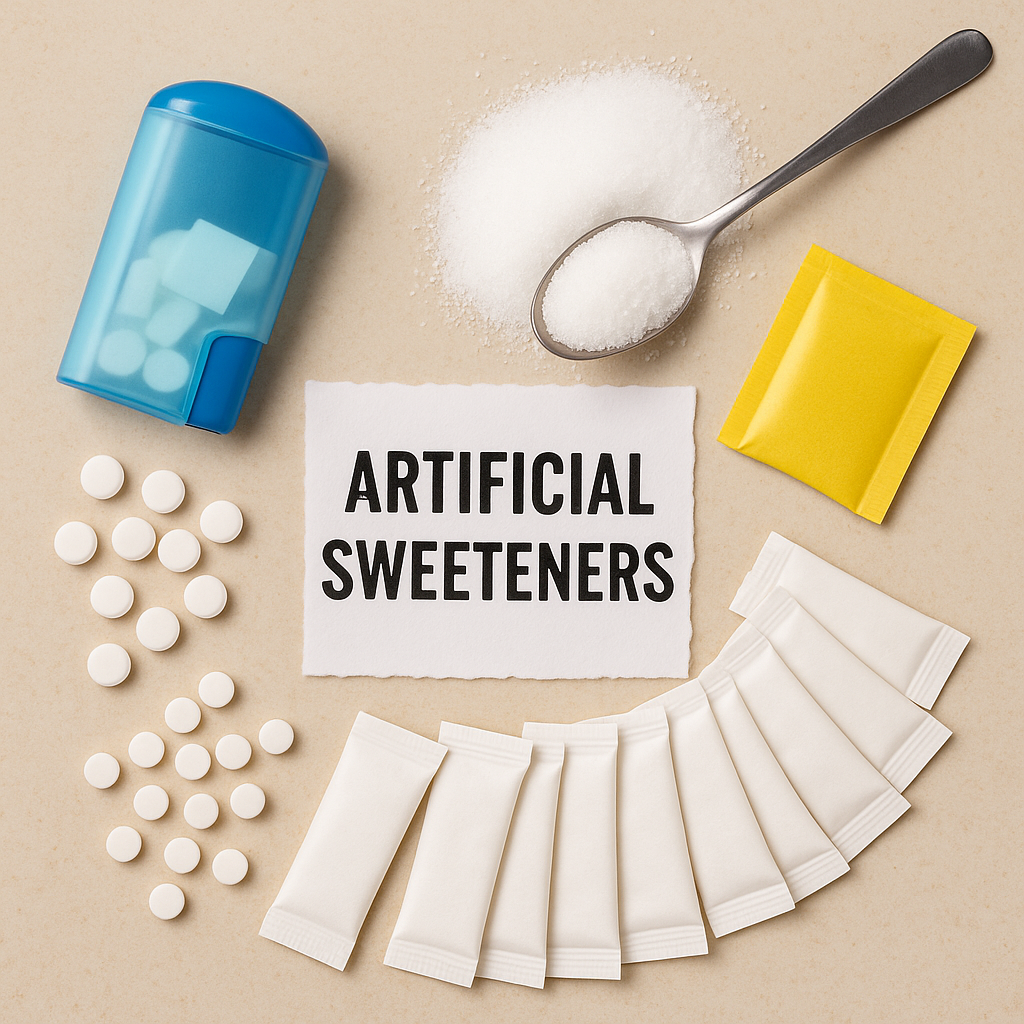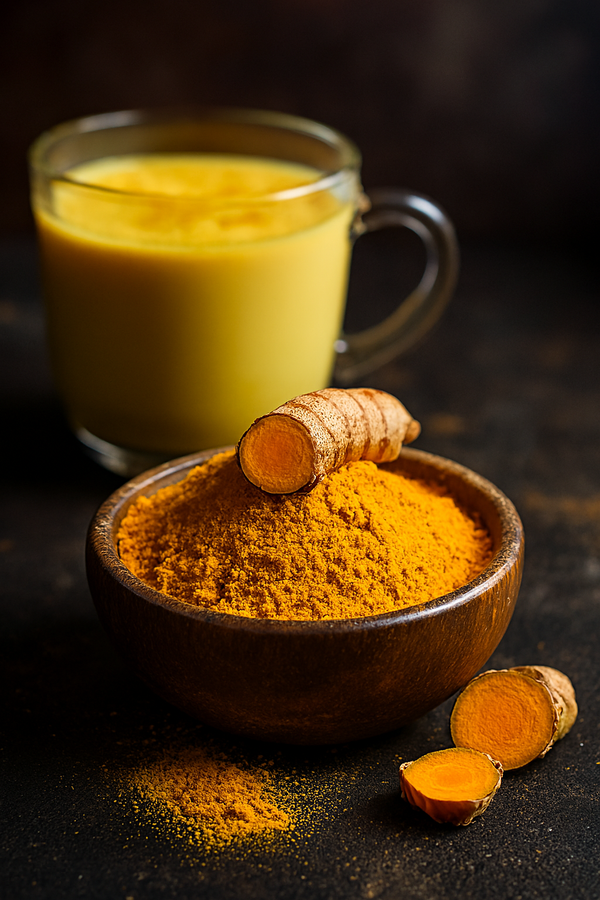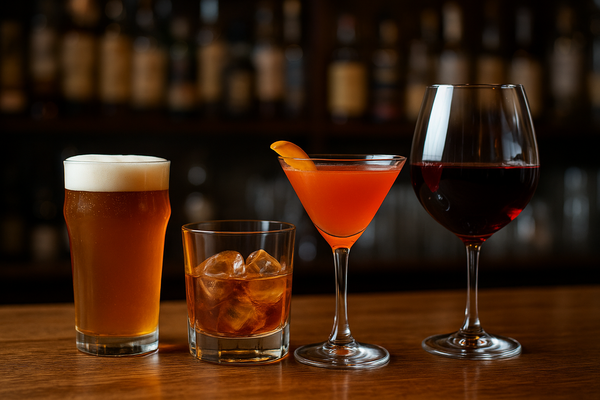Q&A: (Sweeteners Part 2) Sweet Deception of Artificial Sweeteners?
Artificial sweeteners offer low energy but may disrupt metabolism and gut health. Sugar alcohols support dental health but can cause digestive issues. Stevia and monk fruit are natural options with antioxidant benefits. Limit sweetener use overall and prioritise whole foods with natural sweetness.

📌 Take-Home Messages on Sweeteners 🔑
|
Aspect |
Key
Points |
|
Artificial
Sweeteners |
Low-energy
options like aspartame and sucralose, suitable for managing energy but not
ideal for all uses (e.g., baking). ⚖️ ⚠️ May alter gut microbiota, increase
appetite and disrupt glucose regulation. Associated with metabolic
dysregulation and weight gain. |
|
Sugar
Alcohols |
Provide fewer
kilojoules, promote oral health and may aid remineralisation but excessive
consumption can cause bloating, gas and laxative effects.🦷 |
|
Stevia |
A natural,
heat-stable alternative up to 300x sweeter than sugar, with antioxidant and
functional food benefits. Large amounts may affect cause digestive upset in
some.🍃 |
|
Monk-fruit extract |
🍈 Natural,
low-energy sweetener with potential antioxidant effects and minimal reported
side effects; availability and regulatory status vary by region. |
|
Recommendations |
🩺 Limit both
sugar and sweetener use. Prioritise whole foods with natural sweetness (e.g.,
fruits, dairy, vegetables). Avoid artificial sweeteners in children. 🥗🌱 |
Introduction: Sweetness Without Adding Energy 🍬🍃🧪
Finding ways to enjoy sweetness without the health risks associated with high sugar intake has become a major focus in nutrition. Alongside naturally occurring sugars, alternative options such as artificial sweeteners, sugar alcohols, and plant-derived compounds such as stevia have emerged as popular substitutes. Artificial sweeteners are synthetic or naturally derived compounds that provide intense sweetness—hundreds to thousands of times sweeter than sugar—without adding energy. Therefore, they are also referred to as non-nutritive sweeteners. Common examples include aspartame, sucralose, saccharin and acesulfame potassium (K). These sweeteners offer the possibility of reducing energy intake. In addition to sugar, alternative sweeteners such as artificial sweeteners and sugar alcohols offer options for reducing energy intake and possibly managing blood sugar levels (1). Some individuals experience an unpleasant bitter aftertaste—an effect linked to genetic variations in the bitter taste receptor genes TAS2R9 and TAS2R31, which together account for over 13% of the variability in perceived bitterness of acesulfame potassium (2). For those affected by this aversive taste, exploring alternative sweeteners may offer a more palatable solution.
In this article, I explore the different types of low- or no-energy sweeteners, how they are used, their potential health effects, and how they can fit—or sometimes mislead—within a healthy diet.
Artificial Sweeteners🧪🧁
The Food and Drug Administration (FDA) and the European Food Safety Authority (EFSA) rigorously test artificial sweeteners to ensure their safety at typical consumption levels, regulating them with acceptable daily intake (ADI) limits. These sweeteners are commonly used in diet soft drinks and sugar-free products. Though marketed as healthier sugar alternatives, artificial sweeteners have been linked to several negative health effects.
Cancer Concerns Dismissed✅📉
Early cancer fears, based on high-dose animal studies, have largely been dismissed for typical consumption levels with several meta-analyses showing no associations (3-7).
Metabolic and Gut Health Effects🦠🩸
Artificial sweeteners may impact gut microbiota, potentially leading to glucose intolerance, metabolic disorders, and dysbiosis (8-11), and appetite disruption (12, 13). However, results are mixed. In a large metabolomics study, real-world consumption of aspartame and saccharin showed no evidence of metabolic disruptions, suggesting these artificial sweeteners do not alter plasma metabolite profiles under typical intake levels(14).
Overweight and Obesity⚖️⚠️
An umbrella meta-analysis revealed that, in observational studies, artificial sweeteners were associated with a 61% higher risk of overweight and obesity, a pattern not confirmed in more controlled designs (15). This discrepancy reflects reverse causality, as individuals who are already overweight or obese may preferentially choose artificial sweeteners to reduce energy intake. Observational studies, while useful for detecting population-level trends, cannot establish causation and are prone to confounding by dietary habits and health behaviours. A meta-analysis of 19 randomised controlled trials (RCTs)—which are less affected by confounding—found that replacing energy providing sugars with non-nutritive sweeteners led to modest short-term weight loss, particularly in normal-weight and diabetic individuals, while showing minimal benefit in those with obesity (16). Although RCTs strengthen causal inference, they are often limited by short duration (<18 weeks) and challenges with long-term dietary adherence. Long-term, high-quality intervention studies are needed to clarify whether artificial sweeteners ultimately help or hinder weight management.
Type 2 Diabetes⚠️
High intake of both sugar-sweetened and artificially sweetened beverages was associated with an increased risk of type 2 diabetes in Australian adults, underscoring the need for stronger public health policies (17).
Non-alcoholic Fatty Liver Disease Risk 🚫🍺
Non-alcoholic fatty liver disease (NAFLD) is a condition where fat accumulates in the liver in people who consume little or no alcohol. NAFLD is common in people with obesity, type 2 diabetes, and metabolic syndrome. Evidence suggest a link between non-alcoholic fatty liver disease and artificial sweetener use (11). Gut dysbiosis may contribute to NAFLD through mechanisms such as increased endotoxin (LPS) production, altered bile acid metabolism, impaired choline availability and excess production of short-chain fatty acids and ethanol, all of which can promote hepatic lipogenesis and inflammation. Despite growing concerns, most evidence stems from animal studies and more human research is needed to confirm causality and clarify the effects of different sweeteners on liver health (reviewed by Emamat, Ghalandari (11)).
Respiratory Disease Risk🌬️
A prospective study of 210339 adults found that both sugar sweetened beverages but especially artificially sweetened beverages was associated with higher risk of chronic obstructive pulmonary disease (COPD), asthma and asthma with COPD. For every 250 ml (8-ounce) increase in artificially sweetened beverages intake, the risks of COPD, asthma, and asthma with COPD rose by 98%, 65% and 184%, respectively (18).
Hypertension 💓📈⚠️
The relationship between sweetener type and paediatric hypertension is complex. On one hand, substituting added sugars with non-nutritive sweeteners appears beneficial: in a multicentre cohort study of 1,696 Taiwanese children aged 7–17, higher intake of added sugars and aspartame was associated with increased risk of hypertension, particularly in boys and overweight children (19). In contrast, steviol glycosides (from stevia) and acesulfame potassium showed potential protective effects (19).
Cardiovascular and Stroke Risk❤️💥
Evidence suggests a link between artificial sweetener consumption and increased cardiovascular risk.
Table: Summary of Evidence Linking Artificial Sweeteners to Cardiovascular Risk
|
Study/Source |
Population & Design |
Key Findings |
Sweeteners Implicated |
|
Debras, Chazelas (20) |
Over 103,000 French adults; prospective cohort
study |
9% higher risk of cardiovascular disease;
aspartame linked to increased risk of stroke; acesulfame potassium and
sucralose associated with coronary heart disease |
Aspartame, Acesulfame
potassium, Sucralose |
|
Sun, Yang (21) |
133,285 UK adults;
prospective cohort study |
Higher intake of artificial sweeteners linked to
increased risk of cardiovascular disease, coronary artery disease, peripheral
arterial disease, and heart failure; 68–80% of the association mediated by
type 2 diabetes mellitus; non-white and non-obese individuals more vulnerable |
Tabletop sweeteners (e.g., added to
tea/coffee/cereal) |
|
Girigosavi, Etta (22) |
Systematic review |
Artificially sweetened beverages associated with
higher risk of ischaemic stroke, especially in women and Black populations |
Artificially sweetened
beverages |
|
Queiroz, Defante (23) |
Meta-analysis of 12 cohort studies (>1.2
million participants) |
High intake of artificially sweetened beverages
linked to increased risk of all-cause mortality, cardiovascular mortality,
and stroke |
Artificially sweetened
beverages |
Artificial sweeteners may increase cardiovascular risk by disrupting gut microbiota, impairing glucose regulation, promoting unhealthy eating patterns and contributing to metabolic and vascular dysfunction. Evidence suggests they may induce oxidative stress and impair endothelial function, reducing vascular flexibility and promoting atherosclerosis (20).
Neurological and Developmental Concerns🧠👶
Concerns also include neurological effects (24, 25), cognitive decline (26),potential risks during pregnancy (27, 28) and the development of preferences for overly sweet foods , that must be investigated further. Rats exposed to acesulfame K during adolescence exhibited greater avidity for sugars such as fructose, particularly during periods of energy need, alongside structural changes in their taste system, including fewer fungiform papillae on the anterior tongue and a reduced span of circumvallate papillae crucial for taste detection in the posterior tongue (29). Gene expression analysis in these rats revealed decreased activity in pathways related to sweet taste reception, bitter and sweet intracellular signalling, fructose transport, and cellular regeneration in taste-related structures (29). Additionally, there was a reduction in dopamine-producing cells in the ventral tegmental area (VTA), a brain region essential for reward processing (29). These findings suggest early-life exposure to some sweeteners can rewire taste and reward systems. Over an eight-year period, higher consumption of low- and no-calorie sweeteners—especially artificial types and sugar alcohols—was linked to faster cognitive decline, particularly in memory and verbal fluency, among adults under 60, with variations based on diabetes status (26).
Artificial Sweetener Use and Poor Diet Quality🍟🔁
Nutritionists believe that the direct effects of artificial sweeteners, as well as their association with poor dietary quality (30), both contribute to the development of disease.
Table: Factors Linking Artificial Sweetener Intake to Poor Dietary Quality
|
Factor |
Explanation |
|
Compensatory Overeating |
People believe they are
saving energy with artificial sweeteners and then overeat unhealthy foods as
a 'reward'. |
|
Reinforced Sweetness Preference |
Regular intake reinforces
a preference for very sweet tastes, reducing the likelihood of choosing
healthier, less sweet options such as fruits and vegetables. |
|
Association with Ultra-Processed Foods |
Artificial sweeteners are
often found in ultra-processed foods that are low in nutrients but high in
additives, unhealthy fats or sodium. |
|
Misleading Health Perception |
The 'low-energy' or
'sugar-free' labels create a false sense of healthfulness, causing
individuals to prioritise these products over nutrient-dense foods. |
|
Restrictive Dietary Patterns |
Artificial sweeteners are
commonly used in restrictive or weight-loss diets, which often lack balance
and nutrient diversity. |
Special Considerations for PKU⚠️🧬
Phenylketonuria (PKU) is a rare inherited metabolic disorder in which the body cannot properly break down the amino acid phenylalanine (Phe) due to mutations in the PAH gene, which encodes the enzyme phenylalanine hydroxylase. This enzyme is essential for converting phenylalanine into tyrosine. Phenylalanine is found in many protein-rich foods such as meat, eggs, and dairy, as well as in aspartame, an artificial sweetener. Without treatment, phenylalanine accumulates in the blood and brain, leading to intellectual disability, developmental delays, behavioural issues, and neurological problems. PKU is typically detected through newborn screening, and affected individuals must adhere to a lifelong low-phenylalanine diet, avoiding high-protein foods. Additionally, individuals with phenylketonuria (PKU) must avoid aspartame due to its phenylalanine content, which can have dire consequences.
Need for Caution and Further Research🔬
While considered safe in moderation, their long-term effects require further study. Collectively, these findings raise concerns about the role of low-energy sweeteners in promoting unhealthy eating patterns and increasing metabolic health risks later in life. I therefore recommend that adults limit their intake of artificial sweeteners, and that their use be avoided altogether by pregnant women, young children, and adolescents due to potential health risks and developmental concerns.
Sugar with Artificial Sweetener
In South Africa, the sugar tax has led to the emergence of hybrid beverages combining sugar and artificial sweeteners to reduce taxable sugar content while maintaining taste. Although this may lower sugar intake, the health effects of these formulations are unclear, as limited research exists on the combined impact of sugar and sweeteners—raising concerns about their potential metabolic consequences and highlighting the need for further study.
Sugar Alcohols or Polyols🦷🌾
In addition to artificial sweeteners, sugar alcohols, or polyols, are another category of sugar substitutes. These carbohydrates, found naturally in some fruits and vegetables or manufactured from sugars, provide reduced-energy sweetness, typically 25–100% as sweet as sugar. Examples include sorbitol, mannitol, maltitol, xylitol and erythritol often used in chewing gums, breath mints, toothpastes, mouthwashes and cough syrups. Sugar alcohols provide fewer kilojoules (2–3 kJ per gram, with erythritol being non-caloric) and offer additional oral health benefits. Studies indicate that sugar alcohols such as xylitol and erythritol can reduce the incidence of dental caries by facilitating enamel repair and strengthening teeth. Among sugar alcohols, erythritol and xylitol show the greatest potential for preventing caries and promoting remineralisation, likely due to their chemical structure and interaction with oral microbiota (31). This makes them not only a lower-energy sweetener but also a functional choice for oral health. However, excessive consumption can cause digestive discomfort, as they are only partially absorbed in the gut. A case report documented severe allergic urticaria following erythritol consumption (32), underscoring the importance of considering artificial sweeteners and sugar alcohols when diagnosing allergic reactions.
Stevia🍃🧫
Stevia, derived from the sweet-tasting leaves of the Stevia rebaudiana plant native to semi-arid regions of Central and South America and cultivated in areas such as the southwestern United States, is a versatile and natural alternative to sugar (33). Its sweetness, attributed to steviol glycosides, is up to 200–300 times greater than table sugar, making it a potent low-energy sweetener suitable for replacing sucrose. Steviol glycosides are stable, heat-resistant and highly soluble, making stevia a reliable sweetener for various food applications such as baking and cooking (34). It can partially or fully replace sucrose, often combined with other additives to preserve texture and flavour (34). Among these compounds, Rebaudioside A (Reb A) is the most abundant and best-studied steviol glycoside, approximately 200–400 times sweeter than sucrose and valued for its plant-based origin (35). Advanced processing enhances its taste by reducing unpleasant mild bitter or liquorice-like aftertaste. Stevia supports the "clean label" trend, appealing to health-conscious consumers and offers additional benefits such as antioxidant properties and uses as an emulsifier, texturiser and colouring agent, making it ideal for functional and health-promoting products. This systematic review and meta-analysis of 11 clinical trials found that stevia consumption does not significantly affect appetite scores in adults, although a slight increase in the desire to eat was noted when stevia was consumed orally rather than via enteral intake (36). The authors conclude that stevia, as a non-nutritive sweetener, has no major impact on appetite, but recommend more long-term studies for clearer insights (36).
Monk-fruit extract🍈🌍
Monk-fruit extract (luo-han-guo; Siraitia grosvenorii) is a concentrated juice or powdered extract of the Chinese monk-fruit melon that is standardised to mogroside V—the intensely sweet triterpene that gives the fruit 150–250 × the sweetness of sugar while contributing negligible kilojoules (37). In a systematic review Monk fruit extract (MFE) was found to reduce postprandial glucose and insulin levels, particularly in healthy adults, with no serious adverse effects reported (37). Trials also indicated anti-inflammatory and antioxidant properties, as well as symptom-relief effects for throat conditions (37). While approved in the U.S., China, and Canada, its regulatory status remains under review in the EU And long-term studies in broader populations and harmonised regulatory frameworks are needed.
Table: Comparison of Artificial Sweeteners: Sweetness, Safety and Side Effects📊⚠️
|
Artificial
Sweeteners |
Sweetness
Compared to Sugar |
Acceptable
Daily Intake (ADI) |
Potential
Side Effects |
|
Acesulfame
Potassium (Ace-K) |
200x |
15
mg/kg body weight |
Rare
reports of headaches or nausea at high intakes. |
|
Aspartame |
200x |
40
mg/kg body weight |
Headaches,
dizziness, gastrointestinal discomfort in sensitive individuals (38, 39). |
|
Advantame |
20,000x |
32.8
mg/kg body weight |
No
significant adverse effects reported at typical doses. |
|
Cyclamate |
30-50x |
11
mg/kg body weight (not approved in the US) |
Concerns
about carcinogenicity in high doses (animal studies). |
|
Monk-fruit extract |
150–250x |
Not established (Generally
Recognised As Safe - GRAS) |
Rare allergic reactions; may
cause bloating or gas in sensitive individuals. |
|
Neotame |
7,000-13,000x |
0.3
mg/kg body weight |
Minimal
side effects due to low required doses. |
|
Saccharin |
300-400x |
5
mg/kg body weight |
Bladder
cancer concerns (in rodents, not humans at very high doses (3, 4). |
|
Steviol
Glycosides (Stevia; Rebaudioside A or Reb A) |
200-400x |
4
mg/kg body weight (as steviol) |
Possible
hypoglycaemia in sensitive individuals, gastrointestinal effects. |
|
Sucralose |
600x |
5
mg/kg body weight |
Possible
effects on gut microbiota, mild gastrointestinal symptoms. |
The roles of sugar, artificial sweeteners and sugar alcohols differ, catering to various dietary needs. Sugar provides quick energy but lacks nutritional benefits, while artificial sweeteners, sugar alcohols and natural alternatives i.e. stevia offer lower-energy options for those aiming to reduce energy intake or manage conditions such as diabetes. Stevia is heat-stable, making it suitable for baking and cooking. However, aspartame, lose their sweetness when heated and may become chemically unstable, leading to bitterness over time. By understanding these distinctions and considerations, individuals can make informed choices to support a balanced and healthy diet.
Conclusion🧁💡
Sweetness, it seems, rarely comes without strings attached. While sugar, artificial sweeteners, and sugar alcohols each offer distinct advantages—whether it's energy, lower caloric content, or blood sugar stability—they also bring their own set of consequences. Excess sugar intake is a well-established driver of chronic diseases, while artificial sweeteners, although energy-free, are not without potential risks—from gut disturbances to metabolic effects, particularly when overused.
Natural alternatives such as stevia and monk fruit may seem like the "better" choices, but the bigger picture remains: our collective dependence on hyper-sweetened foods may be the real issue. The healthiest strategy isn’t finding the perfect sweetener—it’s gradually dialling back the overall need for sweetness.
Whether managing diabetes, weight, or general wellbeing, the goal should be to reduce reliance on both sugar and its substitutes. Supporting a nutrient-rich, whole-food diet that celebrates natural flavours is the most sustainable way to nourish your body—without tricking your taste buds.
Reflections to Raise Awareness of Sweetener Intake 🪞
· For those with diabetes: Artificial sweeteners and sugar alcohols can help reduce sugar intake, but moderation is essential. Explore how different sweeteners work for you in tea, coffee, baking or smoothies—but always consider whether sweetness is necessary at all. (Also see Reflection 2!)
· Retrain your taste buds: Start reducing overall sweetness in your diet to help your palate adapt. Appreciate the gentle, natural sweetness in whole foods like fruit, carrots and milk. Try adding depth to your drinks with spices such as cinnamon, ginger, or vanilla—without needing added sweetness.
· Read labels consciously: Many processed foods marketed as “sugar-free” contain a blend of sweeteners. Ask yourself: are you swapping one habit for another, or truly reducing your intake?
Love what you’re reading? Share the knowledge! 📨 Forward this link to a friend who might also enjoy it.
References 📘
1. Gibbons C, Beaulieu K, Almiron-Roig E, Navas-Carretero S, Martínez JA, O'Hara B, et al. Acute and two-week effects of neotame, stevia rebaudioside M and sucrose-sweetened biscuits on postprandial appetite and endocrine response in adults with overweight/obesity-a randomised crossover trial from the SWEET consortium. EBioMedicine. 2024;102:105005.
2. Allen AL, McGeary JE, Knopik VS, Hayes JE. Bitterness of the non-nutritive sweetener acesulfame potassium varies with polymorphisms in TAS2R9 and TAS2R31. Chemical senses. 2013;38(5):379-89.
3. Reuber MD. Carcinogenicity of saccharin. Environmental Health Perspectives. 1978;25:173-200.
4. Zurlo J, Squire RA. Is saccharin safe? Animal testing revisited. JNCI: Journal of the National Cancer Institute. 1998;90(1):2-3.
5. Balint IB, Erdodi BT. Is there a promoting role for artificial sweeteners in the evolution of bladder cancer? A meta-analysis of current literature. Minerva Surg. 2024;79(1):92-9.
6. Ye X, Zhang Y, He Y, Sheng M, Huang J, Lou W. Association between Consumption of Artificial Sweeteners and Breast Cancer Risk: A Systematic Review and Meta-Analysis of Observational Studies. Nutr Cancer. 2023;75(3):795-804.
7. Lea IA, Chappell GA, Wikoff DS. Overall lack of genotoxic activity among five common low- and no-calorie sweeteners: A contemporary review of the collective evidence. Mutat Res Genet Toxicol Environ Mutagen. 2021;868-869:503389.
8. Suez J, Korem T, Zilberman-Schapira G, Segal E, Elinav E. Non-caloric artificial sweeteners and the microbiome: findings and challenges. Gut Microbes. 2015;6(2):149-55.
9. Suez J, Korem T, Zeevi D, Zilberman-Schapira G, Thaiss CA, Maza O, et al. Artificial sweeteners induce glucose intolerance by altering the gut microbiota. Nature. 2014;514(7521):181-6.
10. Suez J, Cohen Y, Valdés-Mas R, Mor U, Dori-Bachash M, Federici S, et al. Personalized microbiome-driven effects of non-nutritive sweeteners on human glucose tolerance. Cell. 2022;185(18):3307-28.e19.
11. Emamat H, Ghalandari H, Tangestani H, Abdollahi A, Hekmatdoost A. Artificial sweeteners are related to non-alcoholic fatty liver disease: Microbiota dysbiosis as a novel potential mechanism. EXCLI journal. 2020;19:620.
12. Pearlman M, Obert J, Casey L. The Association Between Artificial Sweeteners and Obesity. Current Gastroenterology Reports. 2017;19(12):64.
13. Yang Q. Gain weight by “going diet?” Artificial sweeteners and the neurobiology of sugar cravings: Neuroscience 2010. The Yale journal of biology and medicine. 2010;83(2):101.
14. Steffen BT, Lusczek ER, Jacobs Jr DR, Chen C, Murthy VL, Van Horn L, et al. No Evidence of Metabolomic Disruptions From Real‐World Intakes of Aspartame or Saccharin: The Coronary Artery Risk Development in Young Adults Study. Journal of Diabetes. 2025;17(8):e70138.
15. Hamedi-Kalajahi F, Asemani S, Prabahar K, Jourabchi-Ghadim N, Ostadrahimi A. The effects of artificial sweeteners on body weight, body fat, and energy intake: A meta-analysis of meta-analyses. BioSocial Health journal. 2024;1(2):74-83.
16. Li D, Han L, Yu Z, Teng X, Ma Y, Wang D. Effects of non-nutritive sweeteners on body weight: a systematic review and meta-analysis of randomized controlled trial (RCT) studies. Journal of Endocrinological Investigation. 2025.
17. Kabthymer RH, Wu T, Beigrezaei S, Franco OH, Hodge AM, de Courten B. The association of sweetened beverage intake with risk of type 2 diabetes in an Australian population: A longitudinal study. Diabetes & Metabolism. 2025:101665.
18. Li S, Xiang Y, Yang X, Chen J, Xian W, Wang Y. Associations of sugary beverage consumption with chronic obstructive pulmonary disease, asthma, and asthma-chronic obstructive pulmonary disease overlap syndrome: a prospective cohort study. Am J Clin Nutr. 2024;120(3):707-18.
19. Tsai Y-J, Fan H-Y, Hsu S-Y, Lin Y-F, Su C-T, Lin H-R, et al. Varied Effects of Sweeteners on Pediatric Hypertension: A Multicenter Study. Clinical Nutrition. 2025.
20. Debras C, Chazelas E, Sellem L, Porcher R, Druesne-Pecollo N, Esseddik Y, et al. Artificial sweeteners and risk of cardiovascular diseases: results from the prospective NutriNet-Santé cohort. Bmj. 2022;378.
21. Sun T, Yang J, Lei F, Huang X, Liu W, Zhang X, et al. Artificial sweeteners and risk of incident cardiovascular disease and mortality: evidence from UK Biobank. Cardiovascular Diabetology. 2024;23(1):233.
22. Girigosavi KB, Etta I, Kambham S, Panjiyar BK. Sweet Surprises: An In-depth Systematic Review of Artificial Sweeteners and Their Association with Cerebrovascular Accidents. Current Nutrition Reports. 2024;13(2):97-105.
23. Queiroz I, Defante MLR, Tavares A, Antunes V, de Mesquita CF, Barbosa LM, et al. High consumption of artificially sweetened beverages and associated risk of cardiovascular events: A systematic review and meta-analysis. Curr Probl Cardiol. 2025;50(1):102837.
24. Kaur R, Das R, Tanwar S, Sajja J. Aspartame and the brain: a systematic review of neurological effects. International Journal of Research in Medical Sciences. 2024;12(8):2977.
25. López-Meza MS, Otero-Ojeda G, Estrada JA, Esquivel-Hernández FJ, Contreras I. The impact of nutritive and non-nutritive sweeteners on the central nervous system: preliminary study. Nutr Neurosci. 2022;25(8):1623-32.
26. Gonçalves NG, Martinez-Steele E, Lotufo PA, Bensenor I, Goulart AC, Barreto SM, et al. Association between consumption of low-and no-calorie artificial sweeteners and cognitive decline: an 8-year prospective study. Neurology. 2025;105(7):e214023.
27. Cai C, Sivak A, Davenport MH. Effects of prenatal artificial sweeteners consumption on birth outcomes: a systematic review and meta-analysis. Public Health Nutr. 2021;24(15):5024-33.
28. Maslova E, Strøm M, Olsen SF, Halldorsson TI. Consumption of artificially-sweetened soft drinks in pregnancy and risk of child asthma and allergic rhinitis. PloS one. 2013;8(2):e57261.
29. Mathes CM, Terrill SJ, Taborda-Bejarano JP, Chometton S, Witt MJ, Mendiratta G, et al. Neurobehavioral plasticity in the rodent gustatory system induced by regular consumption of a low-calorie sweetener during adolescence. Scientific Reports. 2025;15(1):2359.
30. Sylvetsky AC, Mitchell EL, Grilo MF, Um CY, Wang Y, Hodge RA, et al. Cross-sectional associations between consumption of non-nutritive sweeteners and diet quality among US adults in the Cancer Prevention Study-3. The American Journal of Clinical Nutrition. 2024.
31. Mäkinen KK. Sugar Alcohols, Caries Incidence, and Remineralization of Caries Lesions: A Literature Review. International Journal of Dentistry. 2010;2010(1):981072.
32. Hino H, Kasai S, Hattori N, Kenjo K. A Case of Allergic Urticaria Caused by Erythritol. The Journal of Dermatology. 2000;27(3):163-5.
33. Singh S, Rao G. Stevia: The herbal sugar of 21st century. Sugar tech. 2005;7(1):17-24.
34. Schiatti-Sisó IP, Quintana SE, García-Zapateiro LA. Stevia (Stevia rebaudiana) as a common sugar substitute and its application in food matrices: an updated review. Journal of Food Science and Technology. 2023;60(5):1483-92.
35. Makame J, Nolden AA. Distinct sweet taste phenotypes: Investigating perceptual and hedonic responses to non-nutritive and caloric sweeteners. Food Quality and Preference. 2026;136:105759.
36. Zare M, Zeinalabedini M, Ebrahimpour-Koujan S, Azadbakht L. Effects of stevia consumption on appetite in adults: A systematic review and dose-response meta-analysis of randomized controlled trials. Obesity reviews : an official journal of the International Association for the Study of Obesity. 2025:e13902.
37. Kaim U, Labus K. Monk Fruit Extract and Sustainable Health: A PRISMA-Guided Systematic Review of Randomized Controlled Trials. Nutrients. 2025;17(9):1433.
38. Magnuson B, Burdock G, Doull J, Kroes R, Marsh G, Pariza M, et al. Aspartame: a safety evaluation based on current use levels, regulations, and toxicological and epidemiological studies. Critical reviews in toxicology. 2007;37(8):629-727.
39. Butchko HH, Stargel WW, Comer CP, Mayhew DA, Benninger C, Blackburn GL, et al. Aspartame: Review of Safety. Regulatory Toxicology and Pharmacology. 2002;35(2, Supplement):S1-S93.
In developing this work, the author utilised ChatGPT-4 to assist with language editing.




